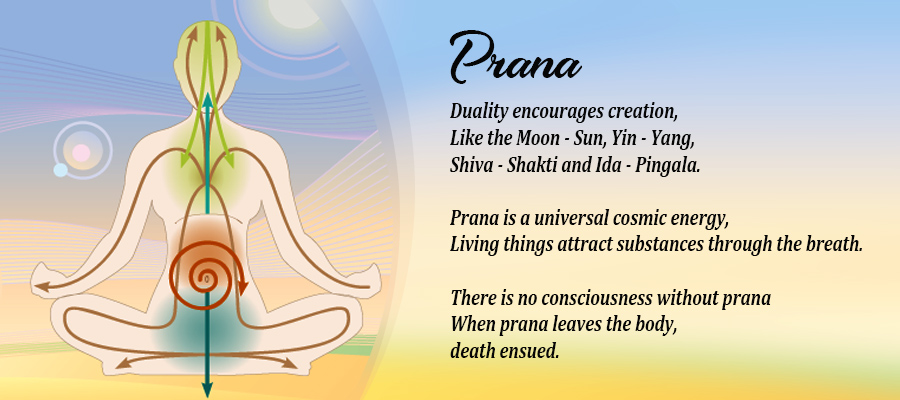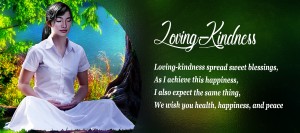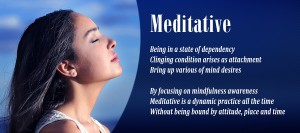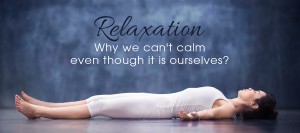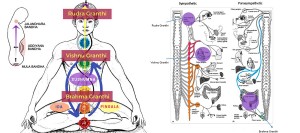- 1Understanding Energy and the Pranic Body
- 2Universal Life Force Energy
- 3The fuel of life
- 4How Prana works in the body
- 5Nadis
- 5.1Three Major Nadis
- 6The Breath – Carrier of Prana
- 6.15 Prana Vayus
- 6.2Relationship between the Chakras, Senses, and Flow of Prana
- 6.3Conscious and unconscious breathing
- 6.4Conducting prana to the brain
- 6.5Rejuvenation of the brain
- 6.6Prana vidya
- 6.7Uniting with the universal prana
- 7PRANA ⇔ CHI ⇔ ELECTRONS ⇔ HEALTH
In the perspective of Yoga, prana is the primordial energy of the universe. Prana is dispersed through the entire material world. “Prana is both macrocosmic and microcosmic and is the substratum of all life.
Prana or Chi is the universal energy or life force. It is the collective total of all energy in the universe, including manifest and dormant energies in nature. Prana remains subtle and motionless in a static state, but is dynamic when activated by vibration and manifests as heat, light, electricity, and magnetism. The word prana comes from the Sanskrit prefix, pra, meaning constant and the root word, an, meaning movement. The etymology of the word, “constant movement”, refers to the vibrational characteristics of energy. The Universe is made of matter and energy. Darwin’s Theory of Evolution suggests that all life originated from the same source and diversity of species was a result of adapting to various environments. In the same way, energy is the source of all life, which manifests into the matter, to create rich contrasts in the world. We live in the physical world where dualities propel creation such as the concepts of the moon and sun, yin and yang, Shakti and Shiva and Ida and Pingala.
Modern science has helped validate the concept of prana. Albert Einstein’s Theory of Special Relativity, E=MC2, expressed matter and energy are the same physical entity that can be changed into each other. In other words, the universe is created by energy, including us humans. More recent findings in quantum physics, such as the String Theory and Higgs Field, only reinforce the concept of prana.
Understanding Energy and the Pranic Body
In our physical body, blood flows through veins, capillaries, and arteries. In our energy body, prana flows through energy pathways called nadis (nadi translates as flow).
Prana rides on the breath, so when we breathe in, we take in prana. When we expand the breadth and improve the quality of it, we are expanding and improving the quality of this vital life force within and around us. This is exactly what yoga breathing techniques, or pranayama, are designed to do.
An important aspect of the pranic body is the chakras or energy centers. In yoga, we focus on the seven major chakras that exist along the line of the spine, each one connected to specific glands and organs of the physical body, as well as areas of our mind that influence our personality.
It is believed by many that health and wellbeing come when there is a balanced energy flow through each of the seven major chakras.
On the flip side, when prana is prevented from flowing naturally, either becoming blocked or overactive at a certain point, it can create disharmony on both a physical and emotional level.
Universal Life Force Energy
Prana is the universal sea of energy that infuses and vitalizes all matter. This sea of energy coalesces into sub-atomic particles and atoms, which become the basic building blocks of all matter manifesting the physical world. So, every atom, molecule, and cell is an extension of prana, just as waves are extensions of the sea that lies beneath them.
Prana is also the power that flows in all living forms and performs vital functions. Paramhansa Yogananda called this aspect of prana “life-force.” He further explained that life-force possesses an inherent intelligence enabling it to carry out life-sustaining processes.
Prana is also used to refer to the breath. When we take a physical breath, there is a corresponding movement of prana in the subtle or astral spine. Prana flows up in the subtle spine in conjunction with the inhalation, and down with the exhalation.
This link between breath and the flow of prana is central to many of the techniques of meditation. By controlling the breath, which is easily felt, we can influence the flow of prana, which is much more subtle and difficult to feel.
The fuel of life
Prana is not merely a philosophical concept; it is in every sense a physical substance. Just as radioactive or electromagnetic waves exist even though we can’t see them, in the same way, in this physical body, there are pranic waves and a pranic field. Now, each of us has a certain quantity of prana in our physical body and we utilize this in the course of our day to day activities throughout life. When our prana diminishes, sickness sets in, and when we have plenty of pranas, every part of the body is in perfect health. If we have an excess of prana, it can be transmitted to others for healing or magnetism.
The inner prana can be stimulated by the practice of pranayama and thereby increased to a greater quantum. The brain requires maximum prana, and for the practice of meditation, it needs an increased supply. It is for this reason that we practice pranayama before commencing our meditation practice. If we are not able to supply plenty of pranic fuel to the brain, the mind becomes very restless and disturbed.
When the brain is receiving a deficient supply of prana, you suffer from nervous depression or nervous breakdown. Then the whole body perspires, there is trembling in every organ, you can’t stand, your mind is unsteady and you are constantly thinking negative thoughts. You can’t even sleep and you don’t want to talk or think. This state indicates that the brain is only receiving a very small quantity of prana.
You should not think that just by practicing a little pranayama you are sending a lot of prana to the brain. The process of supply and assimilation of prana into the brain is very complicated. The brain is a subtle instrument and it can only be enriched by the subtle form of prana and not the gross form. Therefore, when you practice pranayama, you will have to convert the prana into a subtle force.
Deep breathing alone is not enough to stimulate prana. By breathing deeply, you stimulate your respiratory system and the blood circulation, but if you could examine the brain at that time, you would see that it is least affected. However, when you practice pranayama with concentration, as shown by scientific studies, the brainwaves undergo a significant change and the limbic system is also positively influenced.
How Prana works in the body
Without prana, we would have no consciousness. It is the building block of our existence. A fetus shares its mother’s prana and exists as part of the universal consciousness until its fourth month. From there on forward, it begins to form its own consciousness and develops into its individual prana unit. All activities expend energy. We use prana when we move, speak, think, perceive with our senses and to exist. A healthy person is full of vitality and has a good flow of prana. Diseases are caused by improper distribution of prana due to blockage in energy centers and channels. Prana is fueled and replenished by our intake of food, water, solar energy and, most importantly, air. A basic understanding of the distribution of prana in our bodies is crucial in appreciating how yoga balances our bodies, minds, and spirits.
Distribution of Energy via Nadis from Chakras :
Nadis
Prana is distributed to every cell in the body through a complex system of 72,000 energy channels called Nadi, sourcing energy from the Muladhara, root chakra, located at the base of the spine. The word Nadi comes from the Sanskrit word, na, meaning flow, indicating the purpose of the channels to flow through prana. Among the many energy channels, there are three major Nadi which act as prana’s main highways to distribute energy to the different organs and parts of the body. From these major Nadi, minor Nadi branches out to reach every corner of the body.
Three Major Nadis
- Pingala Nadi, which correlates with the sympathetic nervous system, emanates from the Muladhara chakra and starts on the right side of the spine, then curves and passes through the other six chakras. This Nadi ends at the right side of Ajna, third eye chakra, where energy is collected for further distribution. Pingala Nadi conducts prana shakti, the energy which governs the physical functions and is associated with solar and positive energy.
- Ida Nadi emanates from the Muladhara chakra and starts from the left side of the spine, then curves and passes through the other six chakras. Ida Nadi ends at the left side of Ajna, third eye chakra, where energy is collected for further distribution. It is like the mirror opposite to the Pingala Nadi. Ida Nadi conducts Chitta Shakti, the energy which governs the mental functions and is associated with the moon and negative energy.
- Sushumna Nadi emanates from the Muladhara chakra and runs straight up the spine ending at Sahasrara, crown chakra. It conducts the Atma Shakti, spiritual energy, which connects us to higher consciousness. The Pingala and Ida Nadi spiral in and out of the Sushumna Nadi, highlighting how a balanced and unhindered flow of prana in all three major Nadi is necessary for spiritual awakening.
Hatha yoga practices aim at balancing and to ensure the smooth flow of the energy currents in the Pingala and Ida Nadi. The word Hatha means sun and the moon, reflecting Pingala’s solar and Ida’s moon association. Therefore, the purpose of asana practices is to promote prana flow.
The Breath – Carrier of Prana
Pranayama is the fastest and most efficient way to recharge the pranic system and, by doing so, relaxes the body and mind. When yogic breathing practices are done with awareness, prana can be directed to the point of focus. The word pranayama is a compound word composed of prana, energy, and Yama, direction. Therefore, pranayama is a practice of directing energy through the breath. Pranayama is an advanced yoga practice aimed at controlling the breath to be deeper and longer. As the inhalation and exhalation become slower, the breath becomes longer and thus extends life as opposed to when the breath is shorter.
The breath reflects the state of mind of a person. When the breath is short and shallow, a person is angry, fearful or sad. Just by controlling the breath to be longer, a person can quickly shift his or her emotion and become relaxed and achieve a more balanced state of mind. Thus controlling the breath is the key to changing your personality. Negative thoughts drain energy, whereas positive thoughts gain and conserve energy.
Yoga allows us to evolve our minds to maximize our untapped potential. Our personalities are composed of five sheaths or layers, which covers our true self (see koshas diagram). Through practicing pranayama, the prana-maya-kosha, second sheath, and vital energy body, is purified and de-blocked and unleashes our potential through the efficient use of prana. Because the brain uses 25% of the oxygen consumed, the body must be trained to relax so that energy can be used efficiently. Regular pranayama practice is crucial in achieving a relaxed state of body and mind.
5 Prana Vayus
There are 5 prana Vayu, divisions of prana by movement and function, which govern different areas of the body, both physical and subtle. Vayu means wind, suggesting the flow of energy.
- Prana is in the heart but is responsible for providing energy to all glands between Anahata (heart) and Visuddha (throat) chakras. It propels respiration and blood circulation. The movement of the prana is upward. Lack of flow of this type of prana can be corrected through practicing pranayama, backward bending and opening of the chest, especially beneficial to women with tendencies of emotional imbalances. It is particularly important for women to open up the chest since the weight of their breasts pulls their shoulders forward rather than out.
- Apana is in the base of the spine but is responsible for all glands between Muladhara (root) and Svadishthana (sacral) chakras. Its function is excretion and movement is downward. All pelvic asana practices are beneficial for this prana Vayu.
- Samana is in the region of the navel and performs digestion and provides prana to the adrenal gland. The movement of the energy is twisting around the torso. Asanas of twisting the body activate Samana and are beneficial to reduce body fat and control diabetes.
- Udana is in the throat and is responsible for swallowing, balancing the thyroid gland, allowing sleep and separates the spirit from the body at death. Movement is upward. Rotation practices are beneficial for this energy.
- Vyana is the reserve energy and is responsible for blood circulation. Its movement is outward in a circular motion.
5 sub-prana responsible for specific physical functions.
- Naga (burping and hiccupping)
- Koorma (blinking the eyes)
- Krikara (triggering a sense of hunger and thirst)
- Devadatta (yawning)
- Dhananjaya (decomposing the body after death)
Relationship between the Chakras, Senses, and Flow of Prana
The main circuit running in the body is the spine. It connects the brain to all the other parts of the body through the 7 main chakras, energy centers, located along the spine (See Chakra diagram). These energy centers connect us with our sense organs. In yogic science, there are 7 senses. Along with the commonly known 5 senses of sight, sound, smell, taste and touch, there are senses of balance, controlled by ears, and emotion, seated at the heart. The senses connect our outer and inner worlds.
The 7 chakras are a sequential roadmap to our evolution. The root chakra, Muladhara, is the lowest of human chakras but is the highest in the animal kingdom. This energy center is responsible for all human actions necessary for survival. As humans, we must move beyond basic life sustenance and strive towards activating the highest chakra, Sahasrara, in order to reunite with the divine source. Consequently, this chakra, located in the crown, is the base energy center for Gods. The third eye chakra, Ajna, is the point in which the Pingala and the Ida Nadi meet and a balanced union of prana from both circuits creates steadiness and stillness in the body and mind. Stronger will power, clarity of mind and awareness of subtle energy in the body can are manifested as a result of the balance between the energy flow in the two channels. Opening of Ajna results in great mental focus and concentration, access to the 6th sense and expansion of awareness, allowing access to the guidance of universal consciousness. Achieving this state of awareness through practicing yoga allows us to live in happiness, maximize the life span and navigate life with discernment.
Each chakra is responsible for providing energy to specific glands and associated with particular emotions. Unblocked and balanced energy centers manifest positive attributes whereas the contrary will result in negative aspects.
Yoga is a tool to help us realize our own strengths. For example, a physically disabled person may not have all three major Nadi in optimal condition. However, the body is capable of adapting to compromised situations and yoga hastens the process for minor Nadi to step in as replacement energy channel. World-renowned theoretical physicist, Steve Hawkins, who suffers from a rare degenerative disease and only communicates using his cheek muscles, is an inspirational example of how the body continues to accommodate the flow of prana to live life to the fullest.
The mind is the storage of past experiences, memories and all the emotions and impressions that accompanies them. These thoughts clutter our minds to prevent us from being in the present moment, where opportunity and creativity lie. Integral yoga practices must become a daily routine in order for us to live more of our day in the present moment. Besides, asana and pranayama practices, meditation practice is necessary to bring stillness to the mind. The practice of visualizing a flame at the eyebrow center during meditation is an effective practice to bring a deep sense of relaxation. The flame represents our soul. By keeping our focus on our soul, rather than our mind, a stillness comes to the forefront and thoughts fade into the background. The mind gives off measurable brain waves indicating the various levels of state of mind. The beta wave represents the conscious state, alpha wave indicates deep relaxation, and theta wave represents the meditative and pointed focus state. By meditating, we can consciously shift our brain waves from beta to theta. The clarity of mind experienced through meditation is the best time to make important decisions, undisturbed by emotional swings.
In the eagerness to gain awakening, some misguided yogis have promoted the headstand as a way to use gravitational force to direct prana to the crown chakra. Headstands may be enjoyed as a physical practice but not as a shortcut to evolving the mind. We must be discerning about the practices we chose and understand the purpose of the practices in order for them to be beneficial. For example, the dog breathing helps us to become more alert and brings our attention to the present. People who experience dizziness doing the child pose should elevate their heads higher by resting their foreheads on their fists.
Through yoga, we can learn to control and balance our prana flow and to become our own healers. As practitioners, we are experiencing the benefits of yoga in our health, mind, and soul. Over 2,000 years ago, Patanjali, bestowed upon us the wisdom of the Eight Limbs of Yoga, a step-by-step approach to how to live our lives to its full potential. It is time for us to give back to society by sharing the values of yoga with others so that they may also evolve. Plant Patanjali’s tree for others so that they may reap the fruits of yoga.
Conscious and unconscious breathing
The brain can be split into two parts- the frontal brain and the posterior brain. The posterior brain is the instinctive brain that we have inherited through animal incarnations. The frontal brain is the seat of total consciousness. When you breathe without awareness, the breath is registered in the posterior brain, but when you are aware that you are breathing and you are consciously witnessing the whole process, then it is registered by the conscious brain, the frontal brain.
This difference seems to be very simple, but its effect is very great. Throughout life, you breathe unconsciously, just like animals, children and most other people do, excepting for the few who have started practicing yoga. Now, in every case, the pranic flow is being registered in the posterior brain as if on a computer. The moment you become aware of your breathing and you begin to conduct and control the breath in a particular fashion, immediately the frontal brain registers the influence. This fact has been revealed by scientific experiments and has led us to the following conclusion. Conscious breathing has an entirely different effect on the brain than unconscious breathing. Through unconscious breathing, we are definitely able to feed the whole body with prana, but we cannot supply the brain with sufficient prana for its evolution and growth.
Conducting prana to the brain
In order to alleviate sicknesses of the brain, in order to develop the latent capacities of the brain or to initiate the evolution of the brain, we cannot just depend on the way we have been breathing in the past. This is precisely the reason why different forms of pranayama are practiced.
When you practice pranayama, the pranas are stimulated in the lower region of the body, but you must have a means of forcing the pranic energy up. Somehow, you have to create a negative force that will push the pranic energy up through the spinal cord. For this reason, pranayama should be practiced in coordination with specific bandhas. The three bandhas which are incorporated into the practice of pranayama are Jalandhar bandha, uddiyana bandha, and moola bandha. They create a negative force like the ejecting force used to extract water from a well. There are two forces used for pumping water- the sucking force and the ejecting force. When we practice pranayama with the bandhas, we put an ejecting force into action.
So, through pranayama you generate prana in the lower region of the body, then in order to conduct it up to the brain you must first practise moola bandha, then uddiyana bandha and finally jalandhara bandha. Moola bandha is a contraction of the perineum, uddiyana bandha is contraction of the abdominal muscles and jalandhara bandha is the locking of the chin against the sternum. Prana is then conducted to the brain with the help of the subtle circulatory system.
The network of vessels through which the blood circulates is not just an arrangement of hollow tubes. It is a generator and distributor of prana as well. These vessels become charged and polarized as the bloodstream circulates throughout the body. It is as though the whole arterial and venous circulatory trees become magnetized. The flow of blood through the vessels generates a bio-magnetic force just as a forceful flow of water is used to generate hydroelectricity. This is how prana shakti is able to permeate and enliven even the most distant cells and tissues of the body.
Under normal conditions, a certain quantum of prana is circulating, and this is responsible for our present level of health. However, the importance of pranayama is to enable us to consciously generate a higher voltage of prana and this greater quantum of prana can then be directed into the higher centers of the brain, via the cerebral blood vessels and the cerebrospinal fluid circulating and irrigating the brain’s sleep centers. In this way, pranayama brings a higher reality, experience, and dimension to its practitioner. It boosts the level of consciousness by activating and awakening the dormant centers and capacities of the left and right hemispheres of the evolving brain.
Now, another means of conducting prana to the frontal portion of the brain is by the practice of shambhavi mudra. Shambhavi mudra is centralizing the pupils of the eyes at the point between the two eyebrows. This practice is also known as mid-eyebrow center gazing. When you practise shambhavi mudra, the pranas are sucked up by force to irrigate the frontal area of the brain.
Rejuvenation of the brain
In order to charge the brain with sufficient prana, you will have to practice pranayama very systematically. Pranayama is not just a matter of breathing in and breathing out in a particular way. Kumbhaka, retention of breath, is the actual definition of pranayama. Inhalation and exhalation are just a process. In all the ancient yoga texts, kumbhaka has been highly praised, and today scientists are acknowledging what the texts have claimed.
Retention of breath is done at two points. Firstly, when you have filled your lungs, you hold the breath inside, and secondly, when you empty your lungs, you hold the breath outside. Both forms of kumbhaka are important and they are so powerful that they can completely rejuvenate the whole brain.
Prana vidya
In order to develop prana shakti, certain practices have been formulated in many parts of the world. In India, our ancestors developed the science of prana which we call prana vidya. This is a very ancient and effective science which is still practiced in India today.
Some people are born with excess prana, and they are able to transmit that prana out of the body to other people. Although you may not have sufficient prana to be able to do this, you can definitely awaken your own prana and conduct it to any part of the body that requires it. Wherever sickness occurs in the body, there is a deficiency of prana. If you can supply more prana to that part of the body, the process of healing becomes quicker.
I will describe one practice of prana vidya which is not very difficult. While practicing pranayama, visualize Pingala nadi within the spinal cord. As you inhale, follow the structure of Pingala and feel the prana traversing every chakra and finally merging in Ajna chakra. In the same way, feel the prana descending within Pingala Nadi. The color of Pingala is red. So as you inhale and exhale, imagine breathing along a red path. At the end of each inhalation, practice kumbhaka at Ajna chakra.
In order to practice this ascending and descending of prana, you have to perfect ujjayi pranayama. Practice sending prana up and down the spinal cord through Pingala nadi 40 times. Then start distributing prana from Ajna chakra with exhalation. You can send it to any part of the body you choose. If there is a problem with your fingers or your feet or any other part of the body, start sending prana therefrom Ajna chakra. Either with the help of the breath or with the help of your mind, try to push your prana to the affected part of the body. Before long, you will find that healing is taking place.
Uniting with the universal prana
Prana is not only the life force, but it is also a very powerful healing force in the body that can even eradicate the most difficult physical problems. Moreover, the prana within us is a part of the universal prana. I am not talking about positive and negative ions now, I am speaking of a metaphysical substance. This is called universal prana and your prana is a part of that. If you can unite yourself with the universal prana, you can draw the required amount of prana whenever you need it.
In order to tune yourself to this universal prana, you must be able to reach a high state of meditation. When you control the breath, the mind is also controlled and the awareness becomes one-pointed. That one-pointed awareness is comprehended in the mid-eyebrow center where the point is seen as a light. The light grows in intensity and becomes bigger and bigger until it completely envelops your consciousness. Then there is illumination all around you, and at this point, you can connect yourself with the universal prana.
It is very difficult for us to attune ourselves to the universal prana because our awareness is very limited. Most of us only know about deep breathing, and we think that by breathing deeply fifty to a hundred times, we will get more and more shakti. Of course, we do, but we need a finer form of prana shakti which can be used for awakening the brain.
Throughout your body, there is a pranic field which is known as pranamaya kosha. You must know how to tune this pranamaya kosha with the universal prana. Your pranamaya kosha can be awakened by practicing pranayama correctly, by fasting or eating properly, and by perfecting meditation on the mid-eyebrow center. Then, when you are able to see that great enveloping light, you become the medium of the universal prana. Thereafter, you can distribute this prana to those who are in short supply.
PRANA ⇔ CHI ⇔ ELECTRONS ⇔ HEALTH
The arrows indicate the interaction between the elements. These elements are distinct in conception and activity levels. Prana is considered most subtle and non-physical, next is chi which is grosser and is observable and lastly, electrons that interact with physical systems. This model needs to be tested through experimentation; suffice it to say at this time that a more fundamental model for life processes are required if we need to understand health in an organism and the death process.

